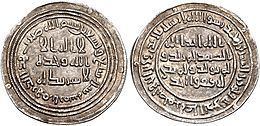Reign 715–717 Name Sulayman Abd Siblings Al-Walid I | Dynasty Umayyad Mother Walida bint Al-Abbas Parents Abd al-Malik ibn Marwan | |
 | ||
Similar People | ||
Between sulayman ibn abd al malik and abu hazim absolutely inspiring
Sulayman bin Abd al-Malik (Arabic: سليمان بن عبد الملك) (c. 674 – 22 September 717) was an Umayyad caliph who ruled from 715 until 717. His father was Abd al-Malik ibn Marwan, and he was a younger brother of the previous caliph, al-Walid I.
Contents
- Between sulayman ibn abd al malik and abu hazim absolutely inspiring
- Early years
- Assumption of power as caliph and his appointments
- Policies as caliph
- Naming of his successor
- Death
- References

Early years
Under the rule of his brother al-Walid he had been the governor of Palestine. In the tribal politics of the Near East at that time (the Qays-Yaman conflict) he allied himself to the Yamanis. When Yazid ibn al-Muhallab escaped from al-Hajjaj, he made his way to Sulayman in Palestine. Sulayman granted him refuge. Al-Hajjaj pressed al-Walid about this and the caliph commanded Sulayman to send him Yazid in chains. Sulayman had his own son chained to Yazid approach al-Walid and present Sulayman's forcefully written letter insisting on sanctuary for Yazid. Al-Walid accepted this and so informed al-Hajjaj.
Assumption of power as caliph and his appointments
Sulayman was hailed as caliph on February 23, 715, the day al-Walid died. He appointed Yazid ibn al-Muhallab governor of Mesopotamia (Iraq) and Salih ibn Abd al-Rahman financial administrator there. Salih was also instructed to arrest and execute the family of al-Hajjaj, one of two prominent leaders (the other was Qutaibah bin Muslim) who had supported the succession of al-Walid's son Yazid, rather than Sulayman. Al-Hajjaj had predeceased al-Walid, so he was no longer alive to pose a threat.
Qutaibah was considerably alarmed at the ascension of Sulayman to the throne. He first sent an envoy to the caliph with letters asserting his loyalty as he was loyal to previous caliphs, urging Sulayman not to replace Qutaibah as governor of Khurasan with Yazid ibn al-Muhallab and, finally, if the envoy saw Sulayman favouring Yazid, with Qutaibah's renunciation of allegiance to Sulayman. Sulayman sent the envoy back with a confirmation of Qutaibah's governorship. However, Qutaibah had already attempted to rebel. Qutaibah's troops rejected his appeal to revolt, killed him and sent his head to Sulayman.
Sulayman appointed Yazid ibn al-Muhallab governor of Khurasan. Yazid was happy to escape the financial strictness of Salih ibn Abd al-Rahman in Mesopotamia (Iraq).
Policies as caliph
As he remained close to the Yamanis, Sulayman did not move to Damascus on becoming Caliph, but rather he remained in Ramla in Palestine. His Khurasani governor Yazid continued expansion into mountainous parts of Iran such as Tabaristan. Sulayman also sent a large army under Maslama ibn Abd al-Malik to attack the Byzantine capital, Constantinople. This was a determined attack that lasted through the winter. The caliph's armies also advanced beyond Byzantine territory and took a Slavic stronghold. The siege of Constantinople occasioned hunger inside the city and among the besiegers. After the intervention of Bulgaria on Byzantine side it ultimately proved to be unsuccessful. Sulayman was on his way to attack the Byzantine border when he died in 717. Sulayman led a conquest of Dahlak Archipelago from Kingdom of Aksum, which became caliphate territory from that point on, although later recovered in the 9th century and vassal to the Emperor of Ethiopia.
In the domestic scene, he had wells built in Mecca for pilgrims, and organized enforcement of prayers. Sulayman was known for his exceptional oratory skills and was fondly remembered.
Naming of his successor
In A.H. 98 (716–717) Sulayman named his son Ayyub heir to the throne. However, Ayyub died that same year. Sulayman considered naming a son to replace him. However, he received advice that it was uncertain the son fighting at Constantinople was still alive and others were too young. So, he passed these over, broke with tradition by not maintaining a hereditary dynasty and appointed Umar ibn Abd al-Aziz as his successor. Umar had a reputation as being one of the most wise, capable and pious persons of that era. This appointment is rare, although it technically fulfils the Sunni Islamic method of appointing a successor, whereas hereditary succession does not.
Death
Sulayman donned an impressive green robe and turban and seeing himself in the mirror commented on how he looked to be in the prime of life. A week later he was dead. He died on either September 22 or October 1, 717. Al-Tabari records the following anecdote: "According to 'Ali--Suhaym b. Hafs: A slave girl belonging to Sulayman looked at him one day, and he asked, "How do you like what you see?" She recited:
You are the best object of delight—if only you would last./ But man does not possess immortality.
I do not know of any blemish in you / that other people have, except that you will pass away.
He was entombed at Dabiq following his death. The tomb was destroyed after the ISIS' takeover of the town in August 2014.
